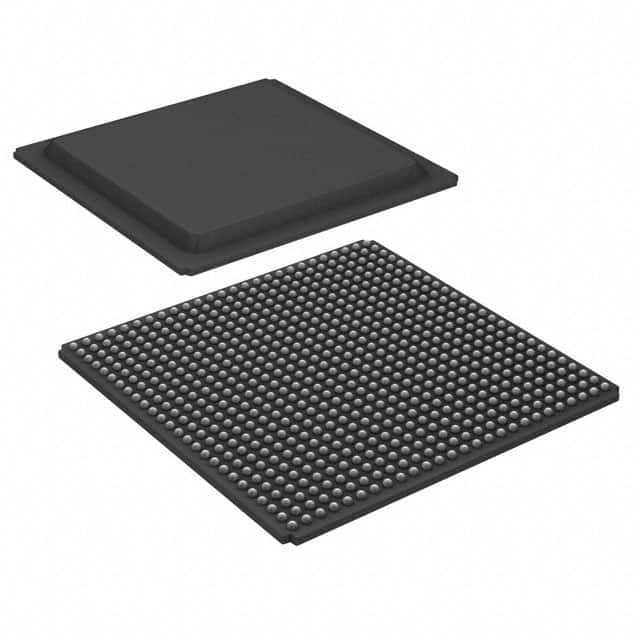Lihat spesifikasi untuk detail produk.

XC7Z035-1FFG676I
Product Overview
Category
XC7Z035-1FFG676I belongs to the category of programmable System-on-Chip (SoC) devices.
Use
This product is commonly used in various electronic applications that require high-performance processing capabilities and flexibility.
Characteristics
- Programmable SoC with integrated processing system and programmable logic
- High-speed performance and low power consumption
- Advanced connectivity options
- Extensive memory interfaces
- Rich set of peripherals and I/Os
Package
XC7Z035-1FFG676I is available in a 676-pin Fine-Pitch Ball Grid Array (FBGA) package.
Essence
The essence of XC7Z035-1FFG676I lies in its ability to combine the functionality of a microprocessor with the flexibility of programmable logic, enabling developers to create highly customized and optimized solutions for their specific application requirements.
Packaging/Quantity
XC7Z035-1FFG676I is typically sold individually or in small quantities, depending on the supplier and customer's needs.
Specifications
Processing System:
- Dual-core ARM Cortex-A9 processor
- Clock frequency: up to 1 GHz
- Floating-point unit (FPU)
- Memory management unit (MMU)
Programmable Logic:
- Programmable logic cells: 35,000
- Look-Up Tables (LUTs): 70,000
- Block RAM: 2.1 Mb
- Digital Signal Processing (DSP) slices: 90
- Clock Management Tiles (CMTs): 4
Memory Interfaces:
- DDR3/DDR3L SDRAM controller
- Quad-SPI Flash interface
- NAND Flash controller
- SD/SDIO controller
Connectivity:
- Gigabit Ethernet MAC
- USB 2.0 ports
- UARTs, I2C, SPI interfaces
Peripherals:
- Timers and watchdogs
- GPIOs
- DMA controllers
- Interrupt controllers
Detailed Pin Configuration
For a detailed pin configuration of XC7Z035-1FFG676I, please refer to the product datasheet or technical documentation provided by the manufacturer.
Functional Features
XC7Z035-1FFG676I offers the following functional features:
- High-performance processing capabilities
- Flexibility and reconfigurability through programmable logic
- Extensive connectivity options for seamless integration with other devices
- Rich set of peripherals and I/Os for versatile application development
- Advanced memory interfaces for efficient data storage and retrieval
Advantages and Disadvantages
Advantages
- Customizable and adaptable to specific application requirements
- High-performance processing capabilities
- Power-efficient design
- Extensive connectivity options
- Large number of programmable logic cells and resources
Disadvantages
- Complexity in design and programming
- Higher cost compared to traditional microcontrollers
- Steeper learning curve for developers unfamiliar with programmable logic
Working Principles
XC7Z035-1FFG676I combines the functionality of a microprocessor and programmable logic. The ARM Cortex-A9 processor handles general-purpose computing tasks, while the programmable logic allows for custom hardware acceleration and peripheral integration. The processor and programmable logic communicate through high-speed interconnects, enabling seamless data transfer and synchronization.
Detailed Application Field Plans
XC7Z035-1FFG676I finds applications in various fields, including but not limited to: - Embedded systems - Industrial automation - Aerospace and defense - Communications and networking - Medical devices - Automotive electronics
Alternative Models
- XC7Z020-1CLG484C
- XC7Z045-2FFG900I
- XC7Z100-2FFG900I
- XC7Z030-2SBG485I
These alternative models offer similar functionality and performance but may have different package options or additional features.
In conclusion, XC7Z035-1FFG676I is a versatile programmable SoC device that combines the power of a microprocessor with the flexibility of programmable logic. With its high-performance capabilities, extensive connectivity options, and rich set of peripherals, it finds applications in various fields. While it offers advantages such as customization and power efficiency, it also has some disadvantages like complexity and higher cost. Developers can choose from alternative models based on their specific requirements.
Sebutkan 10 pertanyaan dan jawaban umum terkait penerapan XC7Z035-1FFG676I dalam solusi teknis
Sure! Here are 10 common questions and answers related to the application of XC7Z035-1FFG676I in technical solutions:
Q1: What is XC7Z035-1FFG676I? A1: XC7Z035-1FFG676I is a specific model of the Xilinx Zynq-7000 series System-on-Chip (SoC) FPGA. It combines an ARM Cortex-A9 processor with programmable logic, making it suitable for a wide range of applications.
Q2: What are the key features of XC7Z035-1FFG676I? A2: Some key features of XC7Z035-1FFG676I include a dual-core ARM Cortex-A9 processor, programmable logic fabric, high-speed interfaces (such as PCIe, USB, Ethernet), on-chip memory, and various peripherals.
Q3: What are the typical applications of XC7Z035-1FFG676I? A3: XC7Z035-1FFG676I can be used in a variety of applications, including industrial automation, automotive systems, aerospace and defense, medical devices, robotics, and high-performance computing.
Q4: How can I program XC7Z035-1FFG676I? A4: XC7Z035-1FFG676I can be programmed using Xilinx's Vivado Design Suite, which provides a comprehensive set of tools for designing, implementing, and debugging FPGA-based systems.
Q5: Can XC7Z035-1FFG676I run an operating system? A5: Yes, XC7Z035-1FFG676I supports running an operating system like Linux on its ARM Cortex-A9 cores. This allows you to leverage the power of both the processor and the programmable logic in your application.
Q6: What are the power requirements for XC7Z035-1FFG676I? A6: The power requirements for XC7Z035-1FFG676I can vary depending on the specific application and configuration. It is important to refer to the datasheet and reference designs provided by Xilinx for detailed power supply recommendations.
Q7: Can XC7Z035-1FFG676I interface with external devices? A7: Yes, XC7Z035-1FFG676I has a wide range of high-speed interfaces, such as PCIe, USB, Ethernet, SPI, I2C, and UART, which allow it to easily interface with external devices and peripherals.
Q8: Is XC7Z035-1FFG676I suitable for real-time applications? A8: Yes, XC7Z035-1FFG676I can be used in real-time applications. Its ARM Cortex-A9 cores can run real-time operating systems (RTOS), and the programmable logic fabric can be used to implement custom hardware accelerators for real-time processing.
Q9: Are there any development boards available for XC7Z035-1FFG676I? A9: Yes, Xilinx offers development boards like the ZedBoard and the Avnet MiniZed, which feature XC7Z035-1FFG676I. These boards provide a convenient platform for prototyping and developing applications using this FPGA.
Q10: Where can I find more information about XC7Z035-1FFG676I? A10: You can find more information about XC7Z035-1FFG676I, including datasheets, user guides, reference designs, and application notes, on the official Xilinx website or by contacting Xilinx support.

